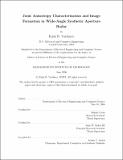Joint anisotropy characterization and image formation in wide-angle synthetic aperture radar
Author(s)
Varshney, Kush R. (Kush Raj)
DownloadFull printable version (3.923Mb)
Alternative title
Image formation and joint anisotropy characterization in wide-angle synthetic aperture radar
Other Contributors
Massachusetts Institute of Technology. Dept. of Electrical Engineering and Computer Science.
Advisor
Müjdat Çetin.
Terms of use
Metadata
Show full item recordAbstract
Imagery formed from wide-angle synthetic aperture radar (SAR) measurements has fine cross-range resolution in principle. However, conventional SAR image formation techniques assume isotropic scattering, which is not valid with wide-angle apertures. Also, the spatial location of scattering centers may migrate as a function of viewing angle across the aperture. The problem of jointly forming images and characterizing anisotropy as well as characterizing scattering center migration in wide-angle SAR is considered in the thesis. The approach not only compensates for anisotropy and migration in the image formation process, but gives much more information, useful for scene interpretation, than a simple image would. A method based on a sparse representation of anisotropic scattering with an over-complete basis composed of basis vectors with varying levels of angular persistence is presented. Solved as an inverse problem, the result is a complex-valued, aspect-dependent response for each scatterer in a scene. The non-parametric approach jointly considers all scatterers within one system of equations. (cont.) The choice of the overcomplete basis set incorporates prior knowledge of anisotropy, but the method is flexible enough to admit solutions that may not match a family of parametric functions. Sparsity is enforced through regularization based on the lp quasi-norm, p < 1, leading to a non-convex minimization problem. A quasi-Newton method is applied to the problem and a novel greedy graph-structured algorithm is developed and also applied. Results are demonstrated on synthetic examples and realistic examples with XPatch data, including the backhoe public release dataset.
Description
Thesis (S.M.)--Massachusetts Institute of Technology, Dept. of Electrical Engineering and Computer Science, 2006. This electronic version was submitted by the student author. The certified thesis is available in the Institute Archives and Special Collections. Includes bibliographical references (p. 145-151).
Date issued
2006Department
Massachusetts Institute of Technology. Department of Electrical Engineering and Computer SciencePublisher
Massachusetts Institute of Technology
Keywords
Electrical Engineering and Computer Science.